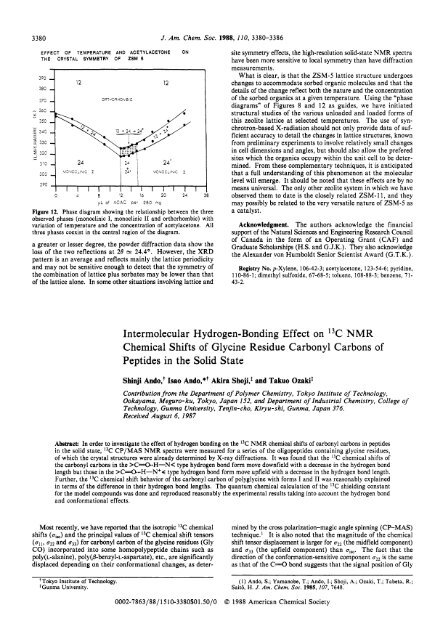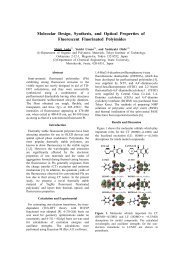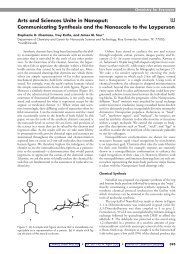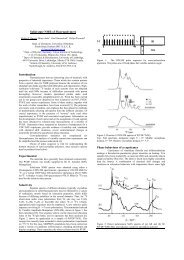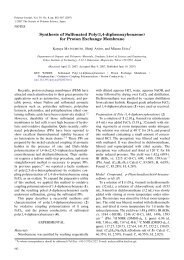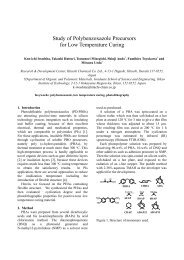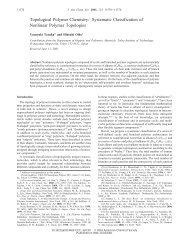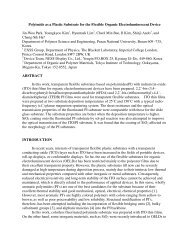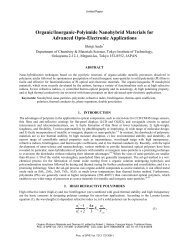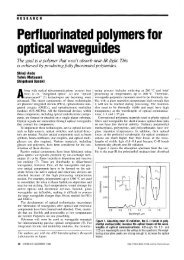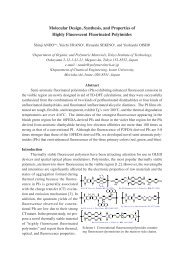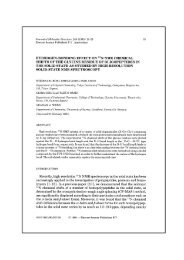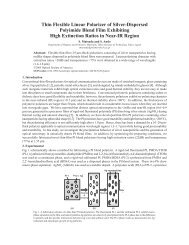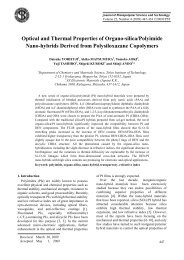Intermolecular hydrogen-bonding effect on carbon-13 NMR ...
Intermolecular hydrogen-bonding effect on carbon-13 NMR ...
Intermolecular hydrogen-bonding effect on carbon-13 NMR ...
Create successful ePaper yourself
Turn your PDF publications into a flip-book with our unique Google optimized e-Paper software.
H-B<strong>on</strong>ding Effect <strong>on</strong> I3C Chemical Shifts of Solid PeptidesCO is closely related to the manner of the <str<strong>on</strong>g>hydrogen</str<strong>on</strong>g> b<strong>on</strong>d whichis formed between amide groups. In additi<strong>on</strong>, the <strong>13</strong>C isotropicchemical shift and u22 comp<strong>on</strong>ent of the carb<strong>on</strong>yl carb<strong>on</strong> in polyglycineform I1 ((Gly), 11; 31-helical form) were displaceddownfield by 3.3 and 5 ppm, respectively, relative to those of formI ((Gly), I; @-antiparallel form). In practice, a str<strong>on</strong>g <str<strong>on</strong>g>hydrogen</str<strong>on</strong>g>b<strong>on</strong>d is formed in form 11, as is evident from the fact that the N-0<str<strong>on</strong>g>hydrogen</str<strong>on</strong>g> b<strong>on</strong>d length is as l<strong>on</strong>g as 2.73 A in (Gly), 11233 comparedwith 2.95 A in (Gly), I.4 From these, it is expected that the GlyCO <strong>13</strong>C chemical shift displacement is related to the <str<strong>on</strong>g>hydrogen</str<strong>on</strong>g>b<strong>on</strong>d length.It is well-known that the <str<strong>on</strong>g>hydrogen</str<strong>on</strong>g> b<strong>on</strong>d plays an importantrole in forming the stable c<strong>on</strong>formati<strong>on</strong>s of polypeptides andproteins. Thus, the nature of the <str<strong>on</strong>g>hydrogen</str<strong>on</strong>g> b<strong>on</strong>d has been widelystudied by various spectroscopic methods. Also, <strong>NMR</strong> has beenused as <strong>on</strong>e of the most powerful tools for obtaining useful informati<strong>on</strong>about the details of the <str<strong>on</strong>g>hydrogen</str<strong>on</strong>g> b<strong>on</strong>d. The I3C <strong>NMR</strong>chemical shift of the carb<strong>on</strong>yl carb<strong>on</strong> is thought to be the mostsensitive to the spatial arrangement of the nuclei comprising the<str<strong>on</strong>g>hydrogen</str<strong>on</strong>g> b<strong>on</strong>d, since the electr<strong>on</strong>ic structure of the carb<strong>on</strong>ylcarb<strong>on</strong> is greatly affected by the <str<strong>on</strong>g>hydrogen</str<strong>on</strong>g> b<strong>on</strong>d. In fact, it wasreported that the formati<strong>on</strong> of the <str<strong>on</strong>g>hydrogen</str<strong>on</strong>g> b<strong>on</strong>d causes adownfield shift <strong>on</strong> the carb<strong>on</strong>yl carb<strong>on</strong> of peptides in the soluti<strong>on</strong>It is, however, difficult to estimate the <str<strong>on</strong>g>hydrogen</str<strong>on</strong>g> b<strong>on</strong>d<str<strong>on</strong>g>effect</str<strong>on</strong>g> <strong>on</strong> the <strong>13</strong>C chemical shift because the observed chemicalshifts of the peptides are often the averaged values for all therotati<strong>on</strong>al isomers owing to an interc<strong>on</strong>versi<strong>on</strong> by rapid rotati<strong>on</strong>in the soluti<strong>on</strong> state. Therefore, chemical shifts in the solid stateprovide useful informati<strong>on</strong> about the <str<strong>on</strong>g>hydrogen</str<strong>on</strong>g> b<strong>on</strong>d of the peptideswith a fixed c<strong>on</strong>formati<strong>on</strong>. Nevertheless, no attempts have beenmade to correlate the manner of the hdyrogen b<strong>on</strong>d and <strong>13</strong>Cchemical shifts of peptide carb<strong>on</strong>yl carb<strong>on</strong>s in the solid state.Therefore, the main purpose of the present work is to measure<strong>13</strong>C chemical shifts of the glycine carb<strong>on</strong>yl carb<strong>on</strong>s in peptidesc<strong>on</strong>taining the glycine residues in the solid state, of which the<str<strong>on</strong>g>hydrogen</str<strong>on</strong>g> b<strong>on</strong>d lengths and the c<strong>on</strong>formati<strong>on</strong>s are determined fromX-ray studies. On the basis of these results, the relati<strong>on</strong>shipbetween the I3C chemical shift and the <str<strong>on</strong>g>hydrogen</str<strong>on</strong>g> b<strong>on</strong>d length willbe discussed. In this study, we chose peptides whose Gly CO inthe amide group is involved in the intermolecular >C-O-H-N
3382 J. Am. Chem. SOC., Vol. 110, No. 11, 1988 Ando et al.Table I. I3C <strong>NMR</strong> Chemical Shifts of Glycine Residue Carb<strong>on</strong>yl Carb<strong>on</strong>s for Oligopeptides C<strong>on</strong>taining Glycine Residues As Determined by I3CCP-MAS <strong>NMR</strong> (k0.2 ppm from TMS) and Their Geometrical Parametersgeometrical parametersH b<strong>on</strong>d"C chemical length/A H b<strong>on</strong>d angle/deg dihedral angled/degsample" typeb shift, b/ppm Ns.0 Hs.0 C=O..N N-He.0 4 $ ref(G~Y*), 11 1 172R 2.73 1.84 158.6 146.2 -78.0 145.8 3Gly-Gly*-L-Val 1 171.1 2.78 1.72 <strong>13</strong>8.3 173.7 -77.1 -22.3 19ClAc-Gly*-Gly 1 170.5 2.82 2.<strong>13</strong> 160.2 147.4 -74.5 154.1 20L-Pro-Gly *-Gly 1 170.0 2.84 2.21 157.0 151.9 -71.3 167.1 21L-Ala-Gly*-Gly 1 170.2 2.93 2.09 152.3 165.8 -83.2 169.4 22(GlY*)" 1 1 169.5c 2.95 2.16 149.2 <strong>13</strong>2.8 146.5 -149.9 4Gly*-Gly 1 168.5 2.97 157.2 152.8 23Gly *-L-Phe-Gly 1 168.1 3.00 2.21 161.8 163.7 127.6 24Gly*-DL-Thr 1 167.8 3.02 2.11 161.2 157.8 -175.0 25Gly*-~-Thr*2H~O 1 168.3 3.05 147.4 -168.7 26L-Val-Gly*-Gly 1 169.1 3.05 2.19 156.6 152.4 -155.1 154.7 27Sar-Gly *-Gly 1 168.6 3.06 2.23 <strong>13</strong>5.0 167.1 72.1 -17.4 28Gly*-GlyHN03 1 166.5 3.12 2.38 161.8 164.6 148.9 29DL-Leu-Gly*-Gly 2 167.0 2.74 170.5 -167.5 -172.3 30Gly*-m-Phe 2 167.5 2.83 2.28 172.8 115.3 -160.3 31Gly*-L-Phe.HC1.H20 2 168.4 2.83 1.93 161.7 152.8 -162.2 32Gly*-Ph*TsOH 2 169.8 2.92 <strong>13</strong>9.5 -179.0 33Gly *-Gly-Val 2 170.9 2.99 2.62 109.9 100.9 -155.8 19"The asterisk indicates the glycine residue whose carb<strong>on</strong>yl carb<strong>on</strong> was measured. bThe manner of <str<strong>on</strong>g>hydrogen</str<strong>on</strong>g> b<strong>on</strong>d. See text. 'Reference 1.C<strong>on</strong>verted to the present tetramethylsilane reference by adding 1 ppm. dFor glycine residue.X',,c,N0IIH>fl;C:H I H A--$E-* 5553L . , . l . . . l . . . l . . I . . I 1 . 1 1 1 . I . I . I , ) . . . II80 168 140 120 100 80 60 48 20(ppm trom TMS)Figure 1. I3C CP-MAS (100.63 MHz) <strong>NMR</strong> spectrum of L-valylglycylglycine.used. The calculati<strong>on</strong> was performed as a functi<strong>on</strong> of <str<strong>on</strong>g>hydrogen</str<strong>on</strong>g> b<strong>on</strong>dlength (the distance between nitrogen and oxygen atoms, abbreviated asRN4) with the same dihedral angles for the skeletal b<strong>on</strong>ds as those of(Gly), I and (Gly), 11.A HITAC M280H computer at the Computer Center of the TokyoInstitute of Technology and a HITAC M200H computer at the ComputerCenter of the Institute for Molecular Science, Okazaki, were usedfor the calculati<strong>on</strong>.Results and Discussi<strong>on</strong><strong>13</strong>C <strong>NMR</strong> Chemical Shifts of the Glycine Carb<strong>on</strong>yl Carb<strong>on</strong>s inPeptides. A 100.63 MHz <strong>13</strong>C CP-MAS <strong>NMR</strong> spectrum of valylglycylglycine(Val-Gly-Gly) using the TOSS pulse techniqueis shown as a typical example in Figure 1. <strong>13</strong>C CP-MAS spectraof the other remaining samples were also obtained with similarresoluti<strong>on</strong>s (figures not shown). Each Gly CO signal can bestraightforwardly assigned, because it is res<strong>on</strong>ated upperfieldcompared with those of the carb<strong>on</strong>yl carb<strong>on</strong>s of other amino acidresidues.'* This upperfield shift arises from the absence of the(18) Howarth, 0. W. Prog. <strong>NMR</strong> Spectrosc. 1978, 12, 1.a. 1-type b. 2-typeFigure 2. Schematic representati<strong>on</strong>s for the two types of <str<strong>on</strong>g>hydrogen</str<strong>on</strong>g> b<strong>on</strong>ds:(a) 1-type and (b) 2-type.C, carb<strong>on</strong> in the Gly residue. The carb<strong>on</strong>yl carb<strong>on</strong> of the C-terminal carboxylic group is res<strong>on</strong>ated downfield by several ppmas a rather sharp peak relative to the internal amide carb<strong>on</strong>ylcarb<strong>on</strong>. The isotropic "C chemical shifts of Gly CO carb<strong>on</strong>sdetermined for all the peptides measured from "C CP-MASspectra are listed in Table I, together with the geometrical parametersobtained by X-ray diffracti<strong>on</strong> studies. <strong>13</strong>C chemical shiftsof the Gly COS in (Gly), I and I1 reported previously' are alsolisted therein. Some of the geometrical parameters were calculatedby using the unit cell parameters and fracti<strong>on</strong>al coordinates inthe literature.(19) Lalitha, V.; Subramanian, E.; Border, J. In?. J. Peptide Protein Res.1984. 24. 437.(20) Rao, S. T. Cryst. Struct. Commun. 1973, 2, 257.(21) Lathitha, V.; Subramanian, E.; Parthasarathy, R. Int. J. PeptideProtein Res. 1986, 27, 223.(22) Lalitha, V.; Subramanian, E. Indian J. Pure Appl. Phys. 1985, 23,506.(23) Biswas, A. B.; Hughes, E. D.; Sharma, B. D.; Wils<strong>on</strong>, J. N. ActaCrystallogr. 1968, 824, 40.(24) Marsh, R. E.; Glusker, J. P. Acta Crystallogr. 1961, 14, 1110.(25) Swaminathan, P. Acta Crystallogr. 1975, 831, 1608.(26) Yadava, V. S.; Padmanabhan, V. M. Acta Crystallogr. 1973, 829,854.(27) Lalitha, V.; Murali, R.; Subramanian, E. In?. J. Peptide Protein Res.1986, 27, 472.(28) Glusker, J. P.; Carrel, H. L.; Berman, M.; Gallen, B.; Peck, R. M.J. Am. Chem. SOC. 1977, 99, 595.(29) Rao, S. N.; Parthasarathy, R. Acta Crystallogr. 1973, 829, 2379.(30) Goswami, K. N.; Yadava, V. S.; Padmanabhan, V. M. Acta Crystallogr.1977, 833, 1280.(31) Marsh, R. E. Acta Crystallogr. 1976, 832, 66.(32) Cotrait, P. M.; Barrans, Y. Acta Crystallogr. 1974, 830, 1018.(33) VanDerVeen, J. M.; Low, B. W. Acta Crystallogr. 1972,828, 3548.
H-B<strong>on</strong>ding Effect <strong>on</strong> "C Chemical Shifts of Solid Peptides169-=2 170-u 4171 -=; 172-173-0030AAA %0027 28 29 30, 31 27 28 29 30 31N 0 LENGTH (A)N 0 LENGTH (ilFigure 3. Plots of the observed I3C chemical shifts in the solid stateagainst the N-0 <str<strong>on</strong>g>hydrogen</str<strong>on</strong>g> b<strong>on</strong>d length (&a) for the 1-type (a) andthe 2-type (b) <str<strong>on</strong>g>hydrogen</str<strong>on</strong>g> b<strong>on</strong>ds. Triangles, open circles, and full circlesdenote Gly CO of the N-terminal glycyl residues, Gly CO of the sec<strong>on</strong>dglycyl residues, and Gly CO of polyglycine, respectively.Figure 2, a and b, shows schematic representati<strong>on</strong>s of the twotypes of <str<strong>on</strong>g>hydrogen</str<strong>on</strong>g> b<strong>on</strong>ds which exist in peptides c<strong>on</strong>sidered hereas classified by the nature of the prot<strong>on</strong>-d<strong>on</strong>ating nitrogen atom.One is denoted as the 1-type <str<strong>on</strong>g>hydrogen</str<strong>on</strong>g> b<strong>on</strong>d which is formedbetween amide >cIo and amide >N-H. The other is denotedas the 2-type <str<strong>on</strong>g>hydrogen</str<strong>on</strong>g> b<strong>on</strong>d which is formed between amide>C-O and N-terminal -NH3+. The 2-type <str<strong>on</strong>g>hydrogen</str<strong>on</strong>g> b<strong>on</strong>d exists<strong>on</strong>ly in oligopeptides with free end-groups, since such a peptideusually exists as a zwitteri<strong>on</strong> in the crystalline state, where theN-terminal is prot<strong>on</strong>ated as NH3+ and the C-terminal is deprot<strong>on</strong>atedas COO-.Figure 3, a and b, shows the plot of I3C chemical shifts of GlyCO against the N.-0 <str<strong>on</strong>g>hydrogen</str<strong>on</strong>g> b<strong>on</strong>d length (RN-0) in the 1-typeand 2-type <str<strong>on</strong>g>hydrogen</str<strong>on</strong>g> b<strong>on</strong>ds, respectively. The <str<strong>on</strong>g>hydrogen</str<strong>on</strong>g> b<strong>on</strong>d<str<strong>on</strong>g>effect</str<strong>on</strong>g> <strong>on</strong> the I3C isotropic chemical shift is entirely differentbetween the two types of <str<strong>on</strong>g>hydrogen</str<strong>on</strong>g> b<strong>on</strong>ds.In the 1-type, a decrease of RN.-O causes a downfield shift.There exists approximately a linear relati<strong>on</strong>ship between RN.-oand the I3C chemical shifts. It is noted that not <strong>on</strong>ly in oligopeptides(dimer or trimer) but also in polypeptides ((Gly), I and11) the Gly CO chemical shifts give a similar <str<strong>on</strong>g>hydrogen</str<strong>on</strong>g> b<strong>on</strong>ddependence. This suggests that the I3C chemical shift of any GlyCO forming the 1-type <str<strong>on</strong>g>hydrogen</str<strong>on</strong>g> b<strong>on</strong>d is predominantly determinedby the manner of <str<strong>on</strong>g>hydrogen</str<strong>on</strong>g> b<strong>on</strong>d. As is evident fromCIO-N and N-H--O angles, most of the 1-type <str<strong>on</strong>g>hydrogen</str<strong>on</strong>g>b<strong>on</strong>ds are neither so bent nor entirely straight, where a preferreddirecti<strong>on</strong> of the <str<strong>on</strong>g>hydrogen</str<strong>on</strong>g> b<strong>on</strong>d approaches the directi<strong>on</strong> of theoxygen atom s$ l<strong>on</strong>e pair. The mean value of the C=%N anglesis 153'. This value is slightly larger than that of 120-<strong>13</strong>0Oobtained by averaging over the angles for N-H.-O=C type<str<strong>on</strong>g>hydrogen</str<strong>on</strong>g> b<strong>on</strong>ds in <strong>13</strong>57 peptides,I0 but the angles of peptidesc<strong>on</strong>sidered here distribute with small discrepancy. Therefore, itcan be expected that the 'length <str<strong>on</strong>g>effect</str<strong>on</strong>g>" <strong>on</strong> the I3C chemical shiftin the 1-type <str<strong>on</strong>g>hydrogen</str<strong>on</strong>g> b<strong>on</strong>d is larger than the 'directi<strong>on</strong> <str<strong>on</strong>g>effect</str<strong>on</strong>g>".Further, the carb<strong>on</strong>yl carb<strong>on</strong>s of N-terminal glycine residues(indicated by triangles) are res<strong>on</strong>ated upperfield from those ofthe inner gycine residues (the sec<strong>on</strong>d residue and polypeptide areindicated by open and full circles, respectively). This may be dueto the difference of <str<strong>on</strong>g>hydrogen</str<strong>on</strong>g> b<strong>on</strong>d length rather than the sequence<str<strong>on</strong>g>effect</str<strong>on</strong>g> of amino acids.This result is similar to that by Imashiro et al.34 that the formati<strong>on</strong>of intra- and intermolecular >C=O-H-O- type <str<strong>on</strong>g>hydrogen</str<strong>on</strong>g>b<strong>on</strong>ds of hydroxybenzaldehydes in the solid state resultsin a downfield displacement of I3C chemical hifts of the carb<strong>on</strong>ylcarb<strong>on</strong> with varying the 0-0 <str<strong>on</strong>g>hydrogen</str<strong>on</strong>g> b<strong>on</strong>d length. Similarly,Berglund and Va~ghan~~ pointed out a similar correlati<strong>on</strong> betweenthe isotropic 'H chemical shift and 0-0 <str<strong>on</strong>g>hydrogen</str<strong>on</strong>g> b<strong>on</strong>d distance.(34) Imashiro, F.; Maeda, S.; Takegoshi, K.; Terao, T.; Saika, A. Chem.Phys. Lerr. 1983, 99, 189.(35) Bergund, B.; Vaughan, R. W. J. Chem. Phys. 1980, 73, 2037.P.bAAJ. Am. Chem. SOC., Vol. 110, No. 11, 1988 3383H? (b) IH /cyH"-77h 0 icn91h RNIFipe 4. Molecular structure of N-acetyl-N'-methylglycine amide: (a)model A (taking the 1-type <str<strong>on</strong>g>hydrogen</str<strong>on</strong>g> b<strong>on</strong>d with two formamide molecules)and (b) model B (taking the 2-type <str<strong>on</strong>g>hydrogen</str<strong>on</strong>g> b<strong>on</strong>d with a prot<strong>on</strong>atedmethylamine molecule). The calculati<strong>on</strong> was made for thecarb<strong>on</strong> marked by asterisks.On the other hand, I3C chemical shifts of the Gly CO arelinearly displaced to upperfield with decreasing RN4 in the 2-type<str<strong>on</strong>g>hydrogen</str<strong>on</strong>g> b<strong>on</strong>d. The directi<strong>on</strong> of the chemical shift change isopposite to that in the 1-type. Such a c<strong>on</strong>siderable differencebetween the two types of <str<strong>on</strong>g>hydrogen</str<strong>on</strong>g> b<strong>on</strong>ds should be resp<strong>on</strong>siblefor the electr<strong>on</strong>ic structure of the groups participating in the<str<strong>on</strong>g>hydrogen</str<strong>on</strong>g> b<strong>on</strong>d. Detailed discussi<strong>on</strong> about the electr<strong>on</strong>ic structuredrawn <strong>on</strong> the basis of quantum chemical calculati<strong>on</strong> will be givenin the following secti<strong>on</strong>. A similar phenomen<strong>on</strong> was also reportedfor the <str<strong>on</strong>g>hydrogen</str<strong>on</strong>g> b<strong>on</strong>d <str<strong>on</strong>g>effect</str<strong>on</strong>g> <strong>on</strong> nitrogen chemical shift that thedirecti<strong>on</strong> and magnitude of the chemical shift change dependcritically <strong>on</strong> the electr<strong>on</strong>ic envir<strong>on</strong>ment around nucleus.36As is seen in Figure 3a, the plots are slightly scattered fromthe dotted straight line. Such a scatter may come from thec<strong>on</strong>formati<strong>on</strong>al <str<strong>on</strong>g>effect</str<strong>on</strong>g> of the skeletal b<strong>on</strong>ds and the experimentalerrors for the determinati<strong>on</strong> of the <str<strong>on</strong>g>hydrogen</str<strong>on</strong>g> b<strong>on</strong>d length. In spiteof the dispersity in C=O--N angles, the 2-type <str<strong>on</strong>g>hydrogen</str<strong>on</strong>g> b<strong>on</strong>dgave a clear linearity between the I3C chemical shift and RN ...Ocompared with the 1-type. This can be attributed to the fact thatthe distributi<strong>on</strong> of distorti<strong>on</strong> angles + about the glycyl residueC,-CO b<strong>on</strong>d in the 2-type is much less than that in the 1-type.The directi<strong>on</strong> <str<strong>on</strong>g>effect</str<strong>on</strong>g> of the <str<strong>on</strong>g>hydrogen</str<strong>on</strong>g> b<strong>on</strong>d is thought to be smallin the 2-type.I3C Shielding C<strong>on</strong>stant Calculati<strong>on</strong>. Figures Sa-d and 6a-dshow the calculated isotropic shielding c<strong>on</strong>stants (ah) and theirparamagnetic terms of tensor comp<strong>on</strong>ents (ullr uZ2, and u33) ofGly CO using the model compounds A and B (Figure 4, a andb) which corresp<strong>on</strong>d to the 1-type and 2-type <str<strong>on</strong>g>hydrogen</str<strong>on</strong>g> b<strong>on</strong>ds,respectively. Calculated values are all expressed in parts permilli<strong>on</strong> (ppm) with an opposite sign to that of Table I. Note thatthe negative sign for the calculated shielding c<strong>on</strong>stant denotesdeshielding, in c<strong>on</strong>trast to the positive sign of the experimentalchemical shift values. A shielding c<strong>on</strong>stant or tensor comp<strong>on</strong>entis usually represented as a sum of the diamagnetic and theparamagnetic terms. However, the behavior of the shielding tensorcan be explained by the paramagnetic term, since the diamagneticterm is isotropic.Figure 5a shows the RNa dependence of the calculated isotropicI3C shielding c<strong>on</strong>stant ( u~) of Gly CO in the 1-ty e <str<strong>on</strong>g>hydrogen</str<strong>on</strong>g>b<strong>on</strong>d. In the regi<strong>on</strong> that RN,..o is larger than 2.6 1, uiso valuesindicate no significant RN-0 dependence in both form I and form11. This means that there exists no <str<strong>on</strong>g>hydrogen</str<strong>on</strong>g> b<strong>on</strong>d <str<strong>on</strong>g>effect</str<strong>on</strong>g> at RN-0> 2.6 A. As shown in Figure Sa, there is significant differencein uiso between form I and form I1 in this regi<strong>on</strong>. This may comefrom the c<strong>on</strong>formati<strong>on</strong> <str<strong>on</strong>g>effect</str<strong>on</strong>g> (c<strong>on</strong>formati<strong>on</strong> change) in going fromform I to form 11. On the other hand, in the regi<strong>on</strong> that RN .ois shorter than 2.6 A, uiso values largely depend <strong>on</strong> the <str<strong>on</strong>g>hydrogen</str<strong>on</strong>g>b<strong>on</strong>d length RN-0, that is, the <str<strong>on</strong>g>hydrogen</str<strong>on</strong>g> b<strong>on</strong>d <str<strong>on</strong>g>effect</str<strong>on</strong>g> is predominant.Therefore, the experimental data that the I3C chemicalshift values largely depend <strong>on</strong> RNq should be compared with thecalculated results at RN-.o < 2.6 A.Here, we must be c<strong>on</strong>cerned with the critical RN.4 value being2.6 A. It seems that this value of 2.6 A is somewhat short comparedwith the experimental data as shown in Figure 3. As the(36) Webb, G. A.; Witanowski, M. Proc. Indian Acad. Sci. 1985,94,241.
3384 J. Am. Chem. SOC., Vol. 110, No. 11, 1988Ando et al.-'87--EB -188 -(a)Form II5 -189-83. -190-s5x -191 --192--220 IN o LENGTU (AII 8 IN 0 LENGTHIL)F i e 5. Variati<strong>on</strong> of the calculated <strong>13</strong>C shielding c<strong>on</strong>stant and its tensorcomp<strong>on</strong>ents with the Ne-0 <str<strong>on</strong>g>hydrogen</str<strong>on</strong>g> b<strong>on</strong>d length (RN4) for the 1-type<str<strong>on</strong>g>hydrogen</str<strong>on</strong>g> b<strong>on</strong>d: (a) isotropic shielding c<strong>on</strong>stant and (b) ullr (e) u22, and(dl 033.-180 -- t8-!81 - -2 -182-e"t -183--184--185-- -190-- 9-200-i2 -210-805 -220-yI -230-3;O-- E. !-320-0-. 5 330-$8 YO-. -350--360-L ' I I2.25 25 215 30 2.25 2.5 235 3.0N 0 .EWGlH IA:N 0 LENGTHIII2.25 2.5 2.75 3.0 2.25 2.5 275 10h 0 LENGTrlii N C .ENGT*IiiFigure 6. Variati<strong>on</strong> of the calculated I3C shielding c<strong>on</strong>stant and its tensorcomp<strong>on</strong>ents with the N-0 <str<strong>on</strong>g>hydrogen</str<strong>on</strong>g> b<strong>on</strong>d length (RNa) for the 2-typehydroge b<strong>on</strong>d: (a) isotropic shielding c<strong>on</strong>stant and (b) uI,, (e) u22, and(4 u33.adopted semiempirical INDO MO approximati<strong>on</strong> neglects sometwo-center electr<strong>on</strong> integrals, the intermolecular interacti<strong>on</strong>s arec<strong>on</strong>sidered to be reproduced reas<strong>on</strong>ably in the short RNa regi<strong>on</strong>3'The variati<strong>on</strong> of the total energy also supports this view as shown(37) Morokuma, K. Chem. Phys. Lett. 1971, 19, 129.20 23 25 275 3C 35N o I ~ ~ ~ . ~ ~ dF i e 7. Variati<strong>on</strong> of the calculated total energy for the 1-type <str<strong>on</strong>g>hydrogen</str<strong>on</strong>g>b<strong>on</strong>d with model A.in Figure 7, where the total energy minimum appears around theRN...o value of 2.3-2.5 8,. Taking into c<strong>on</strong>siderati<strong>on</strong> that the<str<strong>on</strong>g>hydrogen</str<strong>on</strong>g> b<strong>on</strong>d length in a stable c<strong>on</strong>formati<strong>on</strong> is l<strong>on</strong>ger by 0.228, for (Gly), I than for (Gly), II,z4 the "C shielding c<strong>on</strong>stantat the RNa of 2.3 and 2.5 A, as shown by the dotted line, shouldbe taken for form I1 and form I, respectively. As a result, weobtain an appropriate uiso value for form I1 res<strong>on</strong>ated at about1.5 ppm downfield relative to form I. This reproduces the experimentalresult qualitatively. Although u,,~ shows a slightlycomplicated change with RNa, each shielding comp<strong>on</strong>ent changesrather m<strong>on</strong>ot<strong>on</strong>ously. As shown in Figure 5b-d, the particularchange of ulso arises from the fact that uII increases with decreasingRN...O, while u2* decreases with a comparable degree of changefor ull. The difference of u, between form I and form I1 at theRN.* > 2.6 A regi<strong>on</strong> is due to the difference of ull comp<strong>on</strong>ent.This indicates that the above-menti<strong>on</strong>ed c<strong>on</strong>formati<strong>on</strong> <str<strong>on</strong>g>effect</str<strong>on</strong>g> <strong>on</strong>uw can be c<strong>on</strong>tributed by uI1. However, the experimental findingthat the ull is almost independent of c<strong>on</strong>formati<strong>on</strong>al change, asreported previously,' is approximately reproduced in the shorterRN-.0 regi<strong>on</strong> with regard for the difference of <str<strong>on</strong>g>hydrogen</str<strong>on</strong>g> b<strong>on</strong>dlength. On the other hand, the <str<strong>on</strong>g>hydrogen</str<strong>on</strong>g> b<strong>on</strong>d <str<strong>on</strong>g>effect</str<strong>on</strong>g> is evidentin the uZ2 comp<strong>on</strong>ent, which is the dominant factor for thedownfield shift in the shorter RN.-o regi<strong>on</strong>. Accordingly, it canbe said that the ull comp<strong>on</strong>ent and the uz2 comp<strong>on</strong>ent reflectrelatively the c<strong>on</strong>formati<strong>on</strong> <str<strong>on</strong>g>effect</str<strong>on</strong>g> and the <str<strong>on</strong>g>hydrogen</str<strong>on</strong>g> <str<strong>on</strong>g>effect</str<strong>on</strong>g>, respectively,in the 1-type. The calculated u33 comp<strong>on</strong>ent is notsensitive to the changes of RNa while the observed u33 comp<strong>on</strong>entshows a relatively large displacement by changes of the RN..,O asreported previously.' If <strong>on</strong>e judges from the large experimentalerror which arises from the overlapping of the C, signal <strong>on</strong> theregi<strong>on</strong> of uj3 of the powder spectrum, it can be said that the u33comp<strong>on</strong>ent may reflect neither the c<strong>on</strong>formati<strong>on</strong> <str<strong>on</strong>g>effect</str<strong>on</strong>g> nor the<str<strong>on</strong>g>hydrogen</str<strong>on</strong>g> b<strong>on</strong>d <str<strong>on</strong>g>effect</str<strong>on</strong>g>.As shown in Figure 6a, the variati<strong>on</strong> of u,,, in the 2-type <str<strong>on</strong>g>hydrogen</str<strong>on</strong>g>b<strong>on</strong>d gives a satisfactory coincidence with the experimentalresult. The magnitude of change for uI1 is much larger than thatfor u2z and u33, and uI1 changes m<strong>on</strong>ot<strong>on</strong>ically to upperfield withdecreasing R N ~ It . is entirely a dominant factor in determiningthe <str<strong>on</strong>g>hydrogen</str<strong>on</strong>g> b<strong>on</strong>d dependence of the 2-type. Although the uz2comp<strong>on</strong>ent represents the c<strong>on</strong>tributi<strong>on</strong> of deshielding in the samemanner as in the 1-type, this comp<strong>on</strong>ent does not c<strong>on</strong>tribute tothe whole change of a,. The <str<strong>on</strong>g>hydrogen</str<strong>on</strong>g> b<strong>on</strong>d <str<strong>on</strong>g>effect</str<strong>on</strong>g> which appearsin fhe uli comp<strong>on</strong>ent dominates the relative I3C chemical shiftof Gly CO in the 2-type, even in the RN.-O > 2.6 8, regi<strong>on</strong> wherethe c<strong>on</strong>formati<strong>on</strong> <str<strong>on</strong>g>effect</str<strong>on</strong>g> is larger than the <str<strong>on</strong>g>hydrogen</str<strong>on</strong>g> b<strong>on</strong>d <str<strong>on</strong>g>effect</str<strong>on</strong>g>in the 1-type. From the result of calculati<strong>on</strong>s, the origin of thedifference in the experimental results between two types of <str<strong>on</strong>g>hydrogen</str<strong>on</strong>g>b<strong>on</strong>ds is explicitly accounted for in terms of the ull comp<strong>on</strong>ent.Figure 8a shows the directi<strong>on</strong>s of the principal axes of Gly COI3C chemical shift tensor comp<strong>on</strong>ents determined by the <strong>NMR</strong>study of [ l-<strong>13</strong>C]glycyl['5N]glycine.HCI.H20 single crystal,3s and~ ~(38) Stark, R. E.; Jelinski, L. W.; Rubin, D. J.; Torchia, D. A.; Griffin,R. G. J. Magn. Res<strong>on</strong>. 1983, 55, 266.
H-B<strong>on</strong>ding Effect <strong>on</strong> I3C Chemical Shifts of Solid PeptidesFigure 8. Orientati<strong>on</strong> of the principal axes of the observed and calculated"C chemical shift tensors of glycyl residue carb<strong>on</strong>yl carb<strong>on</strong> in (a) gly-~ylglycine.HCl~H~O,~* (b) model A (I-type <str<strong>on</strong>g>hydrogen</str<strong>on</strong>g> b<strong>on</strong>d), and (c)model B (2-type <str<strong>on</strong>g>hydrogen</str<strong>on</strong>g> b<strong>on</strong>d), respectively. The directi<strong>on</strong> of uj3 (notshown here) is perpendicular to the directi<strong>on</strong>s of uII and u2*.parts b and c of Figure 8 show those determined by theoreticalcalculati<strong>on</strong>s performed in this study. The c<strong>on</strong>formati<strong>on</strong> of themodel compounds indicated here is (Gly), I and the RN-.O is 2.5A It is shown that a good agreement was obtained between theexperimental and theoretical results. The uz2 comp<strong>on</strong>ent liesapproximately al<strong>on</strong>g the amide CO b<strong>on</strong>d, and the ull is in theamide sp2 plane and lies al<strong>on</strong>g the directi<strong>on</strong> normal to the C=Ob<strong>on</strong>d. The uj3 comp<strong>on</strong>ent is aligned in the directi<strong>on</strong> perpendicularto the amide sp2 plane. Kempf et al.39 have pointed out that ulland uZ2 comp<strong>on</strong>ents are dominated by singlet-singlet u-** andnq* excitati<strong>on</strong>s, respectively. From a comparis<strong>on</strong> of the behaviorof the calculated ull and uz2 comp<strong>on</strong>ents between the two typesof <str<strong>on</strong>g>hydrogen</str<strong>on</strong>g> b<strong>on</strong>d, the nature of the prot<strong>on</strong>-d<strong>on</strong>ating nitrogen atomis suggested to be very influencial to the electr<strong>on</strong>ic c<strong>on</strong>figurati<strong>on</strong>of the u b<strong>on</strong>d near the carb<strong>on</strong>yl group, but it does not change theproperty of the n<strong>on</strong><str<strong>on</strong>g>b<strong>on</strong>ding</str<strong>on</strong>g> orbital located <strong>on</strong> the carb<strong>on</strong>yl oxygen.The uZ2 comp<strong>on</strong>ent indicates a similar variati<strong>on</strong> between the 1-typeand 2-type <str<strong>on</strong>g>hydrogen</str<strong>on</strong>g> b<strong>on</strong>ds, but ull show a c<strong>on</strong>siderable differencein the two types.In the FPT-INDO calculati<strong>on</strong>, since a shielding c<strong>on</strong>stant isexpressed as a gradient of density matrix elements against themagnetic field," the calculated shielding c<strong>on</strong>stant cannot bedivided into c<strong>on</strong>tributi<strong>on</strong>s from certain <strong>on</strong>e-electr<strong>on</strong> excitati<strong>on</strong>s.However, such an <str<strong>on</strong>g>effect</str<strong>on</strong>g>ive c<strong>on</strong>tributi<strong>on</strong> from a particular excitati<strong>on</strong>can be attributed to the specific shielding comp<strong>on</strong>ents.Therefore, we can differentiate the <str<strong>on</strong>g>hydrogen</str<strong>on</strong>g> b<strong>on</strong>d and c<strong>on</strong>formati<strong>on</strong>al<str<strong>on</strong>g>effect</str<strong>on</strong>g> by elucidating the changes of each I3C shieldingcomp<strong>on</strong>ent as described above.The C<strong>on</strong>formati<strong>on</strong>al Dependence of the Gly CO Cbemical Shift.In order to give a theoretical background to the c<strong>on</strong>formati<strong>on</strong>dependence of the I3C chemical shift, T<strong>on</strong>elliM attempted toexplain the behavior of the chemical shift of polypeptides in termsof the empirical rule of the "gauche y-<str<strong>on</strong>g>effect</str<strong>on</strong>g>". It has been revealedthat this rule is very useful to interpret the I3C chemical shiftsof paraffinic hydr~arb<strong>on</strong>s.~' However, this attempt cannot beapplied for elucidating the chemical shift behavior of C, carb<strong>on</strong>sof peptides. As pointed out by Sait6?, an argument of chemicalshift displacement in terms of the gauche y-<str<strong>on</strong>g>effect</str<strong>on</strong>g> can apply <strong>on</strong>lyto carb<strong>on</strong>yl and C, carb<strong>on</strong>s, not to the C, carb<strong>on</strong>, because C,carb<strong>on</strong>s are located via trans (or rarely cis) arrangement acrossthe amide b<strong>on</strong>d from each other. Nevertheless, chemical shiftsof the C, carb<strong>on</strong> vary appreciably with a c<strong>on</strong>formati<strong>on</strong>al changeexcept for the case of polygly~ine.~~~ In additi<strong>on</strong>, the chemical(39) Kempf, J.; Spiess, H. W.; Haeberlen, U.; Zimmermann, H. Chem.Phys. 1974, 4, 269.(40) !a) T<strong>on</strong>elli, A. E. J. Am. Chem. SOC. 1980,102,7635. (b) T<strong>on</strong>elli,A. E. Biopolymers 1984, 23, 819.(41) Grant, D. M.; Paul, E. G. J. Am. Chem. SOC. 1964, 86, 2984.(42) SaitB, H. Mugn. Res<strong>on</strong>. Chem. 1986, 24, 835.(43) Taki, T.; Yamashita, S.; Satoh, M.; Shibata, A,; Yamashita, T.;Tabeta, R.; SaitB, H. Chem. Left. 1981, 1803.(44) SaitB, H.; Tabeta, R.; Shoji, A.; Ozaki, T.; Ando, I. Mucromolecules1983, 16, 1050.(45) SaitB, H.; Tabeta, R.; Ando, I.; Ozaki, T.; Shoji, A. Chem. Lett. 1983,1437.(46) SaitB, H.; Iwanaga, Y.; Tabeta, R.; Asakura, T. Chem. Letr. 1983,427.(47) SaitB, H.; Tabeta, R.; Asakura, T.; Iwanaga, Y.; Shoji, A.; Ozaki, T.;Ando, I. Macromolecules 1984, 17, 1405.(48) Shoji, A.; Ozaki, T.; SaitB, H.; Tabeta, R.; Ando, I. Macromolecules1984, 17, 1412.(49) SaitB, H.; Tabeta, R.; Shoji, A.; Ozaki, T.; Ando, I.; Miyata, T.Biopolymers 1984, 23, 2279.J. Am. Chem. SOC., Vol. 110, No. 11, 1988 3385shift of the carb<strong>on</strong>yl carb<strong>on</strong> is thought to be characterized by thetorsi<strong>on</strong> angle 4 and to be displaced upfield by several ppm whenthe angl I) takes the value of about 60'. However, the carb<strong>on</strong>ylcarb<strong>on</strong>s of a-helical polypeptides are res<strong>on</strong>ated downfield by 4-7ppm relative to that for @-sheet Similarly, the Gly COchemical shift of (Gly), I1 is res<strong>on</strong>ated downfield by 3.5 ppm fromthat for (Gly), I.] It is noted that the 4 values of the a-helicaland 31-helical form of -58O and -78O,, respectively, are in theallowable angle for the gauche c<strong>on</strong>formati<strong>on</strong>, while that of the@-sheet form is about -150°,4 which is clearly different from thegauche angle.As was menti<strong>on</strong>ed above, (Gly), I1 forms the shorter intermolecular<str<strong>on</strong>g>hydrogen</str<strong>on</strong>g> b<strong>on</strong>d compared with (Gly), I, and the a-helixform is generally stabilized by the str<strong>on</strong>g intramolecular <str<strong>on</strong>g>hydrogen</str<strong>on</strong>g>b<strong>on</strong>d. Apparently, the <str<strong>on</strong>g>hydrogen</str<strong>on</strong>g> b<strong>on</strong>d plays an important rolein determining the I3C chemical shift of carb<strong>on</strong>yl carb<strong>on</strong>s. Further,Pease et reported the solid-state I3C CP-MAS spectrum ofa cyclic peptide, (Gly-Phe-Gly),, where a carb<strong>on</strong>yl carb<strong>on</strong> signalappears at the upfield regi<strong>on</strong> compared with that of the soluti<strong>on</strong>-state<strong>NMR</strong>. It was found that this molecule takes a symmetricform stabilized by two intramolecular <str<strong>on</strong>g>hydrogen</str<strong>on</strong>g> b<strong>on</strong>ds inthe soluti<strong>on</strong> state,', but this symmetry is lost in the crystallinestate accompanying a cleavage of <strong>on</strong>e of the two intramolecular<str<strong>on</strong>g>hydrogen</str<strong>on</strong>g> b<strong>on</strong>dses3 The new signal appearing in the solid statecould arise from the breakdown of <strong>on</strong>e of the two <str<strong>on</strong>g>hydrogen</str<strong>on</strong>g> b<strong>on</strong>dswhich occurs by crystallizati<strong>on</strong>, because the angles of 4 whichare thought to affect to the chemical shifts of both Gly COS inthe solid state are almost identical. On the other hand, SaitS etal.49 reported that the Gly CO peaks of (Pro-Gly-Pro), and(Pro-Ala-Gly), taking collagen-like triple helices are displacedupfield by 5.1 and 4.1 ppm, respectively, compared with that of(Gly), 11. It is noted that there is no appreciable c<strong>on</strong>formati<strong>on</strong>aldifference between the triple helix and 3,-helical (Gly),s. GlyCO in the triple helix does not participate in the <str<strong>on</strong>g>hydrogen</str<strong>on</strong>g> b<strong>on</strong>d,while a str<strong>on</strong>g <str<strong>on</strong>g>hydrogen</str<strong>on</strong>g> b<strong>on</strong>d is formed in (Gly), 11. They showthat the <str<strong>on</strong>g>hydrogen</str<strong>on</strong>g> b<strong>on</strong>d causes the downfield shift in (Gly), 11.This coincides with the previous results obtained by the tightbindingMO calculati<strong>on</strong> for (Gly), I and 11 which takes intoaccount the <str<strong>on</strong>g>hydrogen</str<strong>on</strong>g> b<strong>on</strong>d between the inter chain^.^^As menti<strong>on</strong>ed above, the quantum chemical calculati<strong>on</strong> showsthat the <str<strong>on</strong>g>hydrogen</str<strong>on</strong>g> b<strong>on</strong>d <str<strong>on</strong>g>effect</str<strong>on</strong>g> <strong>on</strong> the chemical shift is dominantin the vicinity of the <str<strong>on</strong>g>hydrogen</str<strong>on</strong>g> b<strong>on</strong>d length at RN..o< 2.6 A, butat RN ...O > 2.6 A, the c<strong>on</strong>formati<strong>on</strong> <str<strong>on</strong>g>effect</str<strong>on</strong>g> becomes dominant asshown in Figure 5 because of the rapid reducti<strong>on</strong> of the <str<strong>on</strong>g>hydrogen</str<strong>on</strong>g>b<strong>on</strong>d strength owing to the increase of the <str<strong>on</strong>g>hydrogen</str<strong>on</strong>g> b<strong>on</strong>d length.For polypeptides with no <str<strong>on</strong>g>hydrogen</str<strong>on</strong>g> b<strong>on</strong>ds such as the abovementi<strong>on</strong>ed(Pro-Gly-Pro), and (Pro-Ala-Gly),, the chemical shiftdifference of 1 ppm between Gly COS of the two polypeptides isattributed <strong>on</strong>ly to their c<strong>on</strong>formati<strong>on</strong>al change.It can be said, therefore, that the quantum chemical calculati<strong>on</strong>can separate successfully the c<strong>on</strong>formati<strong>on</strong>al <str<strong>on</strong>g>effect</str<strong>on</strong>g> and the <str<strong>on</strong>g>hydrogen</str<strong>on</strong>g>b<strong>on</strong>d <str<strong>on</strong>g>effect</str<strong>on</strong>g> <strong>on</strong> the chemical shift of Gly CO of peptides,the former being dominant in the regi<strong>on</strong> of l<strong>on</strong>g <str<strong>on</strong>g>hydrogen</str<strong>on</strong>g> b<strong>on</strong>dlength (or in no <str<strong>on</strong>g>hydrogen</str<strong>on</strong>g> b<strong>on</strong>d) and the latter in the regi<strong>on</strong> ofshort <str<strong>on</strong>g>hydrogen</str<strong>on</strong>g> b<strong>on</strong>d length. In other words, the Gly CO chemicalshift in the solid state can be interpreted in terms of a change inelectr<strong>on</strong>ic structure caused by the formati<strong>on</strong> of <str<strong>on</strong>g>hydrogen</str<strong>on</strong>g> b<strong>on</strong>das well as c<strong>on</strong>formati<strong>on</strong>al change.Finally we can c<strong>on</strong>clude as follows. The observed <strong>13</strong>C chemicalshift in the amide type <str<strong>on</strong>g>hydrogen</str<strong>on</strong>g> b<strong>on</strong>d moves linearly downfieldwith a decrease of the <str<strong>on</strong>g>hydrogen</str<strong>on</strong>g> b<strong>on</strong>d length. This could bejustified by quantum chemical calculati<strong>on</strong>. These results may beapplicable to the biopolymer field as a means for obtaining in-(50) Ramachandran, G. N.; Sasisekharan, V. In Aduances in ProteinChemistry; Academic: New York, 1968.(51) Pease, L. G.; Frey, M. H.; Opella, S. J. J. Am. Chem. Soc. 1981,103,467.(52) Pease, L. G.; Deber, C. M.; Blout, E. R. J. Am. Chem. Soc. 1973,95, 258.(53) Kostansek, E. C.; Thiessen, W. E.; Schomburg, D.; Lipscomb, W. N.J. Am. Chem. SOC. 1979, 101, 5811.(54) Yamanobe, T.; Ando, I.; SaitB, H.; Tabeta, R.; Shoji, A,; Ozaki, T.Bull. Chem. Soc. Jpn. 1985, 58, 23.
3386J. Am. Chem. SOC. 1988, 110, 3386-3392formati<strong>on</strong> about the <str<strong>on</strong>g>hydrogen</str<strong>on</strong>g> b<strong>on</strong>d length or <str<strong>on</strong>g>hydrogen</str<strong>on</strong>g> b<strong>on</strong>dstrength in the solid state.Registry No. H-Gly-Gly-Val-OH, 20274-89-9; CIAc-Gly-Gly-OH,15474-96-1; H-Pro-Gly-Gly-OH, 7561-25-3; H-Ala-Gly-Gly-OH, 3 146-40-5; H-Gly-Gly-OH, 556-50-3; H-Gly-Phe-Gly-OH, 14656-09-8; H-Gly-or-Thr-OH, 27 174-1 5-8; H-Gly-Thr-OH, 7093-70- 1; H-Val-Gly-Gly-OH, 21835-35-8; H-Sar-Gly-Gly-OH, 18479-98-6; H-Gly-Gly-OH.HN03, 50998-1 2-4; H-or-Leu-Gly-Gly-OH, 4337-37-5; H-GIY-DL-Phe-OH, 721-66-4; H-Gly-Phe-OH-HC1, 78410-67-0; H-Gly-Phe-OH.TsOH, 40301 -89-1; H-Gly-OH, 56-40-6; glycine homopolymer, 257 18-94-9; polyglycine, SRU, 25734-27-4.Low-Temperature 3C Magnetic Res<strong>on</strong>ance. 8. ChemicalShielding Anisotropy of Olefinic Carb<strong>on</strong>slaAnita M. Orendt, Julio C. Facelli, Alvin J. Beeler, Karl Reuter, W. J. Hort<strong>on</strong>,Peter Cutts, David M. Grant,* and Josef Michl*lbC<strong>on</strong>tributi<strong>on</strong> from the Department of Chemistry, University of Utah,Salt Lake City, Utah 84112. Received August 14, 1987Abstract: The principal values of the "C <strong>NMR</strong> shielding tensor were measured at cryogenic temperatures for a series of olefiniccarb<strong>on</strong>s, including methyl-substituted ethylenes, 1 -methyl- and 1,2-dimethylcycloalkenes, methylenecycloalkanes, and bicyclo[n.m.O]alkenes.Informati<strong>on</strong> <strong>on</strong> the orientati<strong>on</strong> of the principal axes was obtained from ab initio calculati<strong>on</strong>s of the chemicalshielding tensors using the IGLO (individual gauge for localized orbitals) method. The results for several compounds withunusual principal values of the shielding tensor were analyzed in terms of the b<strong>on</strong>d c<strong>on</strong>tributi<strong>on</strong>s in the principal axis system.Over the last several years the combinati<strong>on</strong> of low-temperatureI3C <strong>NMR</strong> spectroscopy with the quantum mechanical calculati<strong>on</strong>of the chemical shielding tensor has been shown to be very valuablein the interpretati<strong>on</strong> of chemical shielding data in small organicmolecules.2 Studies <strong>on</strong> carb<strong>on</strong> atoms in a wide range of <str<strong>on</strong>g>b<strong>on</strong>ding</str<strong>on</strong>g>situati<strong>on</strong>s have been completed, including methyl groups? methinecarb<strong>on</strong>s: and methylene carb<strong>on</strong>^.^ Other studies have lookedat carb<strong>on</strong>s in linear molecules6 and in the series cyclopropane,bicyclo[ 1.1 .O] butane, and [ l.l.l]pr~pellane.~ The calculati<strong>on</strong>swere used to determine the orientati<strong>on</strong> of the principal axis systemof the chemical shielding tensor in the molecular frame, informati<strong>on</strong>that is not determined experimentally from naturalabundance powder samples.Previously the experimental chemical shielding values for thecycloalkenes from cyclopropene to cyclooctene, ethylene, cis-2-butene, and trans-2-butene were reported.8 For the sake ofcompleteness these experimental results are also included hereal<strong>on</strong>g with their calculated shielding tensors. A previous experiment<strong>on</strong> ethylene-1 ,2-I3C2 provided the orientati<strong>on</strong> of the principalaxis system in the molecular frame. The findings were thatthe downfield comp<strong>on</strong>ent, ull, was perpendicular to the doubleb<strong>on</strong>d and lay in the plane of the molecule, u22 was al<strong>on</strong>g the double(1) (a) For part 7 in this series, see ref 3. (b) Present address: Departmentof Chemistry, University of Texas at Austin, Austin, Texas 78712-1167.(2) Facelli, J. C.; Grant, D. M.; Michl, J. Acc. Chem. Res. 1987, 20, 152.(3) Solum, M. S.; Facelli, J. C.; Michl, J.; Grant, D. M. J. Am. Chem. Soc.1986, 108, 6464.(4) Facelli, J. C.; Orendt, A. M.; Solum, M. S.; Depke, G.; Grant, D. M.;Michl, J. J. Am. Chem. Soc., 1986, 108. 4268.(5) Facelli, J. C.; Orendt, A. M.; Beeler, A. J.; Solum, M. S.; Depke, G.;Malsch, K. D.; Downing, J. W.; Murthy, P. S.; Grant, D. M.; Michl, J. J. Am.Chem. SOC. 1985, 107, 6749.(6) Beeler, A. J.; Orendt, A. M.; Grant, D. M.; Cutts, P. W.; Michl, J.;Zilm, K. W.; Downing, J. W.; Facelli, J. C.; Schindler, M.; Kutzelnigg, W.J. Am. Chem. Soc. 1984, 106, 7672.(7) Orendt, A. M.; Facelli, J. C.; Grant, D. M.; Michl, J.; Walker, F. H.;Dailey, W. P.; Waddell, S. T.; Wiberg, K. B.; Schindler, M.; Kutzelnigg, W.Theor. Chim. Acta 1985, 68, 421.(8) Zilm, K. W.; C<strong>on</strong>lin, R. T.; Grant, D. M.; Michl, J. J. Am. Chem. SOC.1980, 102, 6672.(9) Zilm, K. W.; Grant, D. M. J. Am. Chem. SOC. 1981, 103, 29<strong>13</strong>.b<strong>on</strong>d, and u33 was perpendicular to the double b<strong>on</strong>d and to theplane of the molecule. Similar orientati<strong>on</strong>s have been found inseveral single-crystal studies,I0J1 and in another dipolar study12<strong>on</strong> more complicated alkene derivatives. Early theoretical studieshave also shown the same results for the orientati<strong>on</strong> of the shieldingtensors.I3-l6In this paper, the experimental principal values of the shieldingtensor as well as the calculated results are presented for a widerange of olefinic carb<strong>on</strong>s. The types of olefinic carb<strong>on</strong>s that arestudied can be divided into five groups: methyl-substitutedethylenes, cycloalkenes, 1 -methyl- and 1,2-dimethylcycloalkenes,methylenecycloalkanes, and bicyclo[n.m.O]alkene. The structuresof the compounds studied are shown in Figure 1.Experimental and Computati<strong>on</strong>al MethodsMaterials. Commercial samples of tetramethylethylene, methylenecyclobutane,methylenecyclopentane, propene, 1 methylcyclopentene, andisobutene were used without any further purificati<strong>on</strong>. A sample of 1,2-dimethylcyclobutene was provided by Professor D. Aue (University ofCalifornia at Santa Barbara). The precursor for the synthesis of bicycl0[2.2.0]hex-l(4)-eneas well as a sample of bicyclo[3.2.0]hept-l(4)-enewas provided by Professor K. B. Wiberg (Yale University). Drs. P. J.Okarma and J. J. Caringi (Yale University) provided a sample of bicyclo[3.3.0]oct-l(5)-ene.The remaining compounds were synthesized according to publishedliterature procedures: methylenecyclopropane,*' 1,2-bismethylenecyclobutane,181,2-dimethylcy~lohexene,'~ bicycl0[3.2.0]hept-l(5)-ene,~~ bi-(10) Wolff, E. K.; Griffin, R. G.; Waugh, J. S. J. Chem. Phys. 1977, 67,2387.(11) Igner, D.; Fiat, D. J. Magn. Res<strong>on</strong>. 1982, 46, 233.(12) Manenschijn, A.; Duijvestijn, M. J.; Smidt, J.; Wind, R. A,; Yann<strong>on</strong>i,C. S.; Clarke, T. C. Chem. Phys. Lett. 1984, 112, 99.(<strong>13</strong>) Ditchfield, R.; Ellis, P. D. In Topics in '.'C <strong>NMR</strong> Spectroscopy;Wiley: New York, 1974; Vol. 1.(14) Ditchfield, R.; Miller, D. P.; Pople, J. A. J. Chem. Phys. 1971, 54,4186.(15) Str<strong>on</strong>g, A. B.; Ikenberry, D.; Grant, D. M. J. Mugn. Res<strong>on</strong>. 1973,9,145; errata: 1976, 21, 157.(16) Ebraheem, K. A. K.; Webb, G. A. In Progress in <strong>NMR</strong> Spectroscopy;Pergam<strong>on</strong> Press: Oxford, 1977; Vol. 11.(17) Salaun, J. R.; Champi<strong>on</strong>, J.; C<strong>on</strong>ia, J. M. Org. Synrh. 1977, 57, 36.(18) Borden, W. T.; Reich, I. L.; Sharpe, L. A,; Weinberg, R. B.; Reich,H. J. J. Org. Chem. 1975, 40, 2438.0002-7863/88/1510-3386$01.50/0 0 1988 American Chemical Society


